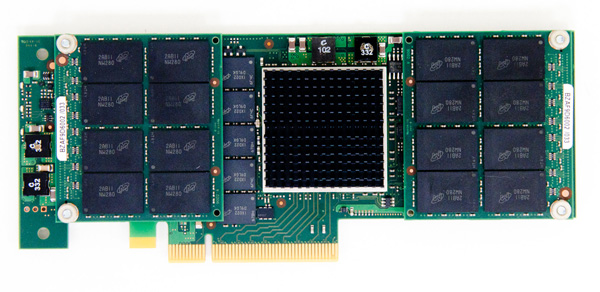Micron P320h PCIe SSD (700GB) Review
by Anand Lal Shimpi on October 15, 2012 3:00 AM ESTFinal Words
Update: Micron tells us that the P320h doesn't support NVMe, we are digging to understand how Micron's controller differs from the NVMe IDT controller with a similar part number.
For Micron's first PCIe SSD, the P320h performs very well. Random read and write performance are untouched by any non-SandForce architecture we've tested here. Average service times in our application based workload traces are also class leading, presumably as a result of the IDT controller and lightweight PCIe controller. Sequential performance is also very good and potentially even better under heavier workloads. The fact that there's no claimed performance difference between the 350GB and 700GB drives is good for users who don't have giant workload footprints. Overall it's an impressive step forward. The native PCIe architecture makes a lot of sense and will hopefully quickly supplant the current crop of SATA-RAID-on-a-PCIe-card solutions on the market today. Where things will get really interesting is when we start coupling multiple PCIe SSDs in a system.
The downsides to the P320h are obvious. By using 34nm SLC NAND Micron ensures wonderful endurance, but prices the solution out of the reach of many customers whose needs don't require such high endurance. Until Micron brings eMLC/MLC-HET NAND to the P320h, I suspect the more conventional PCIe SSDs (e.g. Intel's SSD 910) will remain better values. For the subset of users who require SLC endurance however, the P320h should definitely fit the bill.
The second downside is just as fundamental: the driver stack is still in its infancy. Although the ultimate goal is SATA-like compatibility with all systems, it will take some time to get there. Until that day comes, if you're considering the P320h you'll want to make sure that Micron has validated the drive on your platform.
PCIe is the future. I don't expect a smooth ride to get us there, but it's where solid state storage is headed - particularly in the enterprise market. The P320h is a good starting point, I'm eager to see where Micron takes it.











57 Comments
View All Comments
itanic - Monday, October 15, 2012 - link
Isn't this essentially just what FusionIO has been doing all along, except without all the drivers/software surrounding it?FunBunny2 - Monday, October 15, 2012 - link
That's my understanding. As to who IDT is?webdev511 - Monday, October 15, 2012 - link
IDT (Integrated Device Technology) has been doing IC controllers for a Loooooong time.iamkyle - Wednesday, October 17, 2012 - link
How can you not remember the IDT WinChip!?ericgl21 - Monday, October 15, 2012 - link
I wish they could have made a bootable SSD card, so the UEFI BIOS can see it as any other storage component. After all, it would be nice to have an OS installed directly on it.extide - Monday, October 15, 2012 - link
For home /power users, yeah you'd want that, but for this thing's target market booting from it is not an issue.blackmagnum - Monday, October 15, 2012 - link
Want SSD storage at the sweetspot of 1 dollar/ 1 gigabyte.Zak - Monday, October 15, 2012 - link
There are plenty of SSDs, although SATA not PCIe, for less than $1 per gigabyte.colonelpepper - Monday, October 15, 2012 - link
$2,000+ USD for a 2TB drive???...in other news, I'd like to buy a 32 inch LCD screen at the sweetspot price of $16,000.
melgross - Monday, October 15, 2012 - link
There's a sweet spot for RAM, in varying sizes, HDD's and SSD's. they're all different.